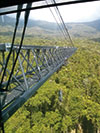
James Cook University’s (JCU) Daintree Rainforest Observatory has an osprey nest on top of a crane near the canopy – the uppermost rainforest layer that encompasses the branches and leaves of the trees and serves as the richest habitat for plant and animal life. To enable Daintree researchers to monitor the ospreys, JCU needed a camera that could be mounted in a delicate position and a system that could monitor the ospreys’ movements and everything happening in and around the nest. They also needed flexible video data storage management and a system that was easy for research fellows to download and use.
JCU enlisted the help of CoastalCOMS, a company specialising in cloud-hosted environmental digital asset management and a Milestone Solutions Partner. CoastalCOMS mounted a Sony VM632R network camera at the end of the crane boom and a robotic SNC-WR630 on the crane tower. CoastalCOMS use a fibre-optic cable to connect the cameras to the server room.

The camera, which operates at one megabit per second, sends its data for viewing and recording on Milestone XProtect Essential video management software (VMS).
With a camera mounted on the crane, researchers are able to closely monitor the birds without disturbing them. They can also isolate video segments to capture still shots of the ospreys to export and share. The easy-to-use VMS interfaces allow research fellows with no prior VMS experience to quickly download and monitor the osprey camera output from various remote research facilities.

JCU’s Daintree Rainforest Observatory is one of only five long-term ecological monitoring sites in Australia. There are two laboratories on-site, one open-air teaching lab and one traditional, air-conditioned laboratory equipped to support the basic needs of most rainforest research.
The Observatory also has the Canopy Crane, which allows researchers to explore the rainforest from above, where the atmosphere is different, down through its various levels and into the soils and subterranean water resources. The wide variety of micro-climates present in the rainforest make it possible for researchers to conduct many experiments they could not conduct elsewhere, such as exposing a small section of the rainforest to drought conditions to test the effects.
Nigel Sim, application development manager for CoastalComs, a division of Coastalwatch, says the ospreys have been nesting in Daintree for years, but now the Milestone solution is giving them the chance to finally observe them up close.
“Researchers had no reliable way to access them,” Sim says. “We thought about a GoPro camera, but it was way too inconvenient to have to constantly shift the camera angles and send people to collect the footage. With Milestone, we have every setting and feature we could want at our fingertips – remotely. It’s an incredibly powerful monitoring tool.”
Chris Lane, GM for Coastalwatch, says that the day after the cameras were installed, the ospreys began to investigate their new neighbour and the result was stunning. “The birds were curious from the start,” Lane says. “They would fly right up to the camera and poke their heads around it. Nigel and I happened to be around the observatory one day, and one of the people monitoring the camera excitedly called us into the control room. Milestone VMS had recorded the osprey looking right into the lens! Nigel archived a two-minute clip of her flying up into the nest and back down, and we isolated single frames from the VMS. There’s an incredible shot of her looking out at the entire rainforest. It’s one of the best shots we’ve ever captured.”
Lane says that research fellows are encouraged to download Milestone Mobile on their phones and tablets and are provided with logins to view the cameras and extract imagery. “It’s been a big success,” Sim says. “We have a steady stream of happy research fellows using Milestone for various projects. They pick it up really quickly.”
Lane is excited to share the osprey cam with the public in the near future. “Right now the nest is comprised of two ospreys bringing up their young in that nest,” Lane says. “My hope is that in 12-18 months, satellite connections will improve to the point that we can stream the camera live to the public, so they can get as excited as we are about it. We may even be able to show a live hatch.”
Nigel Sim says, based on the success of the osprey cam, researchers asked that five static Sony VM632R) cameras be installed to monitor a group of possums they thought were living in a certain place. When the cameras went live, they saw that no possums were there after all. However, a large colony of tree ants had made its home there.
“While it turned out to be a completely different research project, we got incredible footage of these enormous ants,” Lane says. “The ecologists were super-excited to get live shots of the ant nest getting built. Without Milestone, none of this would have happened.”
Lane says there are also cameras monitoring penguins in Victoria. “They’re affiliated with the penguins on Phillip Island, which is the biggest penguin colony in mainland Australia,” Lane says. “With just a camera or two connected to Milestone, biologists and ecologists are now able to do research that just a few years ago they were only dreaming about.”
For more information contact Milestone Systems, +27 (0)82 377 0415, [email protected], www.milestonesys.com
| Tel: | +27 10 500 8793 |
| Email: | [email protected] |
| www: | www.milestonesys.com |
| Articles: | More information and articles about Milestone Systems |
© Technews Publishing (Pty) Ltd. | All Rights Reserved.